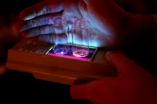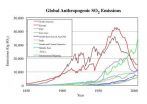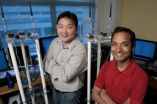(Press-News.org) ANN ARBOR, Mich.---Pure organic compounds that glow in jewel tones could potentially lead to cheaper, more efficient and flexible display screens, among other applications.
University of Michigan researcher Jinsang Kim and his colleagues have developed a new class of material that shines with phosphorescence---a property that has previously been seen only in non-organic compounds or organometallics.
Kim and his colleagues made metal-free organic crystals that are white in visible light and radiate blue, green, yellow and orange when triggered by ultraviolet light. By changing the materials' chemical composition, the researchers can make them emit different colors.
The new luminous materials, or phosphors, could improve upon current organic light-emitting diodes (OLEDs) and solid-state lighting. Bright, low-power OLEDs are used in some small screens on cell phones or cameras. At this time, they aren't practical for use in larger displays because of material costs and manufacturing issues.
The OLEDs of today aren't 100 percent organic, or made of carbon compounds. The organic materials used in them must be spiked with metal to get them to glow.
"Purely organic materials haven't been able to generate meaningful phosphorescence emissions. We believe this is the first example of an organic that can compete with an organometallic in terms of brightness and color tuning capability," said Kim, an associate professor of materials science and engineering, chemical engineering, macromolecular science and engineering, and biomedical engineering.
This work is newly published online in Nature Chemistry.
The new phosphors exhibit "quantum yields" of 55 percent. Quantum yield, a measure of a material's efficiency and brightness, refers to how much energy an electron dissipates as light instead of heat as it descends from an excited state to a ground state. Current pure organic compounds have a yield of essentially zero.
In Kim's phosphors, the light comes from molecules of oxygen and carbon known as "aromatic carbonyls," compounds that produce phosphorescence, but weakly and under special circumstances such as extremely low temperatures. What's unique about these new materials is
that the aromatic carbonyls form strong halogen bonds with halogens in the crystal to pack the molecules tightly. This arrangement suppresses vibration and heat energy losses as the excited electrons fall back to the ground state, leading to strong phosphorescence.
"By combining aromatic carbonyls with tight halogen bonding, we achieve phosphorescence that is much brighter and in practical conditions," said Onas Bolton, a co-author of this paper who recently received his Ph.D. in Materials Science and Engineering.
This new method offers an easier way to make high-energy blue organic phosphors, which are difficult to achieve with organometallics.
Organic light emitting diodes are lighter and cheaper to manufacture than their non-organic counterparts, which are made primarily of ceramics. Today's OLEDs still contain small amounts of precious metals, though. These new compounds can bring the price down even further, because they don't require precious metals. They're made primarily of inexpensive carbon, oxygen, chlorine and bromine.
"This is in the beginning stage, but we expect that it will not be long before our simple materials will be available commercially for device applications," Kim said. "And we expect they will bring a big change in the LED and solid-state lighting industries because our compounds are very cheap and easy to synthesize and tune the chemical structure to achieve different colors and properties."
Former doctoral student Kangwon Lee discovered the unique properties of these materials while developing a biosensor---a compound that detects biological molecules and can be used in medical testing and environmental monitoring. The phosphors have applications in this area as well. After Lee's discovery, Bolton developed the metal-free pure-organic phosphors.
The paper is titled "Activating efficient phosphorescence from purely-organic materials by crystal design." In addition to Kim, Bolton, and Lee, other contributors are: former postdoctoral researcher Hyong-Jun Kim in the Department of Materials Science and Engineering and recent Chemical Engineering graduate Kevin Y. Lin. This work is partly funded by the National Science Foundation and the National Research Foundation of Korea.
The university is pursuing patent protection for the intellectual property, and is seeking commercialization partners to help bring the technology to market.
INFORMATION:
For more information:
Jinsang Kim: http://www.mse.engin.umich.edu/people/faculty/kim
Michigan Engineering:
The University of Michigan College of Engineering is ranked among the top engineering schools in the country. At $180 million annually, its engineering research budget is one of largest of any public university. Michigan Engineering is home to 11 academic departments, numerous research centers and expansive entrepreneurial programs. The College plays a leading role in the Michigan Memorial Phoenix Energy Institute and hosts the world-class Lurie Nanofabrication Facility. Michigan Engineering's premier scholarship, international scale and multidisciplinary scope combine to create The Michigan Difference. Find out more at http://www.engin.umich.edu/.
EDITORS: Images available at: http://ns.umich.edu/Releases/2011/Feb11/phosphor.html
Jewel-toned organic phosphorescent crystals: A new class of light-emitting material
2011-02-15
ELSE PRESS RELEASES FROM THIS DATE:
Treating the aging knee as an organ
2011-02-15
DETROIT – The human body is made up of several organs composed of tissues that enable them to perform a particular function. The heart circulates blood; the brain is the micro-neuro center of the body; the lungs bring in oxygen and release carbon dioxide.
The failure of any one of these tissue systems can cause serious health issues, even death. When components of the organ are fixed, typically the organ functions better. For instance, unclogging a blocked artery with a balloon stent improves blood circulation to and from the heart.
Henry Ford Hospital researcher Fred ...
Does social anxiety disorder respond to psychotherapy? Brain study says yes
2011-02-15
When psychotherapy is helping someone get better, what does that change look like in the brain? This was the question a team of Canadian psychological scientists set out to investigate in patients suffering from social anxiety disorder. Their findings are published in Psychological Science, a journal of the Association of Psychological Science.
Social anxiety is a common disorder, marked by overwhelming fears of interacting with others and expectations of being harshly judged. Medication and psychotherapy both help people with the disorder. But research on the neurological ...
UCLA Engineering advance with new nanomaterials good news for next-generation electronic devices
2011-02-15
In recent years, topological insulators have become one of the hottest topics in physics. These new materials act as both insulators and conductors, with their interior preventing the flow of electrical currents while their edges or surfaces allow the movement of a charge.
Perhaps most importantly, the surfaces of topological insulators enable the transport of spin-polarized electrons while preventing the "scattering" typically associated with power consumption, in which electrons deviate from their trajectory, resulting in dissipation.
Because of such characteristics, ...
Physicists isolate bound states in graphene-superconductor junctions
2011-02-15
CHAMPAIGN, Ill. — Illinois researchers have documented the first observations of some unusual physics when two prominent electric materials are connected: superconductors and graphene.
Led by University of Illinois physics professor Nadya Mason, the group published its findings in the journal Nature Physics.
When a current is applied to a normal conductor, such as metal or graphene, it flows through the material as a stream of single electrons. By contrast, electrons travel in pairs in superconductors. Yet when a normal material is sandwiched between superconductors, ...
Psychology students to present on cheaper textbook alternatives at national conference
2011-02-15
A group of University of Cincinnati seniors in the psychology program will nationally present their comparison of educational technology alternatives to purchasing college textbooks that can run into hundreds of dollars per academic quarter. Their research as part of the statewide Ohio Digital Bookshelf Project will be presented on Monday, Feb. 14, at the national EDUCAUSE Annual Meeting in Washington, DC.
The Digital Bookshelf Project is an initiative under the University System of Ohio (USO) Strategic Plan for Higher Education to develop a high-quality, affordable, ...
Gene that regulates immune system linked to preeclampsia
2011-02-15
Researchers at North Carolina State University have discovered that the placentas of women who suffer preeclampsia during pregnancy have an overabundance of a gene associated with the regulation of the body's immune system. Their discovery may lead to improved screening and prenatal care for these patients and their babies.
Preeclampsia occurs in up to 10 percent of all pregnancies, and is responsible for about 15 percent of pre-term births. The disorder is usually marked by a rapid rise in blood pressure that can lead to stroke, seizures or organ failures in the mother. ...
Study shows year-end test scores significantly improved in schools using Web-based tutor
2011-02-15
WORCESTER, Mass. – Year-end test scores of Massachusetts middle school students whose teachers used a Web-based tutoring platform called ASSISTments as a central part of their mathematics instruction were significantly better than those of students whose teachers did not use the platform, according to a recent study published in the Journal of Educational Computing Research. Conducted by Neil T. Heffernan, PhD, of Worcester Polytechnic Institute (WPI), and Kenneth R. Koedinger, PhD, and Elizabeth A. McLaughlin, both of Carnegie Mellon University, the study examined data ...
Worldwide sulfur emissions rose between 2000-2005, after decade of decline
2011-02-15
COLLEGE PARK, Md. -- A new analysis of sulfur emissions appearing in the journal Atmospheric Chemistry and Physics shows that after declining for a decade, worldwide emissions rose again in 2000 due largely to international shipping and a growing Chinese economy. An accurate read on sulfur emissions will help researchers predict future changes in climate and determine present day effects on the atmosphere, health and the environment.
"Sulfur dioxide is an important component of the atmosphere. It changes the radiative balance of the earth by influencing the amount of ...
Early signs of heart disease in preadolescent children with type 1 diabetes
2011-02-15
Cardiovascular disease is the leading cause of death in patients with diabetes. Patients with type 1diabetes have a 200 percent to 400 percent greater chance of developing cardiovascular disease than those without diabetes. Medical College of Wisconsin researchers at Children's Hospital of Wisconsin discovered the early signs of cardiovascular disease are likely to manifest before the onset of puberty in many children with diabetes.
Those findings are published in the February 2, 2011 online version of Diabetes Care and will be in the March 2011 issue of Diabetes Care.
Led ...
Stanford researchers develop new wireless technology for faster, more efficient networks
2011-02-15
VIDEO:
A new technology that allows wireless signals to be sent and received simultaneously on a single channel has been developed by Stanford researchers. Their research could help build faster, more...
Click here for more information.
"Wireless communication is a one-way street. Over."
Radio traffic can flow in only one direction at a time on a specific frequency, hence the frequent use of "over" by pilots and air traffic controllers, walkie-talkie users and emergency ...



